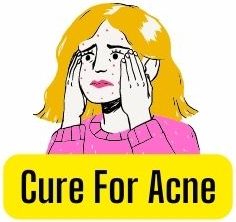If you are one of the many people who suffer from hairline acne, you know how frustrating and embarrassing it can be. Acne in this area can be difficult to treat, but with the right information and products, you can get rid of it for good! In this definitive guide, we will discuss what causes hairline acne, how to identify it, and how to treat it using both over-the-counter and prescription medications. We will also cover some tips on how to prevent future breakouts. Let’s get started!
How do you know if you have hairline acne
The first step is to identify the symptoms. Hairline acne typically manifests as small, red bumps along the hairline. These bumps can be hard or soft, and they may be painful or itch. In some cases, hairline acne may also cause inflammation and swelling. If you notice any of these symptoms, it’s important to see a doctor or dermatologist for an accurate diagnosis.
They will likely perform a skin examination and may order other tests, such as a skin biopsy, to rule out other conditions. Once hairline acne is diagnosed, treatment typically revolves around managing sebum production and preventing further irritation. This can be done with a variety of over-the-counter and prescription medications.
Understand the cause of hairline acne
Hairline acne can be a frustrating condition, especially because the breakouts seem to have no rhyme or reason. However, there are a few things that can contribute to this type of acne. First, sweat and oil can build up on the skin along the hairline, creating the perfect environment for bacteria to thrive.
In addition, tight hats and headbands can irritate the skin and trap sweat and oil against the hairline. Finally, hair products such as gels and sprays can also clog pores and lead to breakouts. Fortunately, there are a few things that you can do to help prevent hairline acne. Be sure to wash your face daily with a gentle cleanser, and avoid using oily hair products. In addition, try to avoid wearing tight hats and headbands. If you do happen to get a breakout, you can try using a benzoyl peroxide gel or a salicylic acid peel.
Identify your skin type to determine the best treatment
Acne is a common skin condition that can affect people of all ages. One type of acne, called folliculitis, occurs when the hair follicles become inflamed. This can happen for a variety of reasons, including infection, irritation, or blockage of the follicle. Folliculitis often appears as small red bumps on the skin, and it can occur on any part of the body where hair grows. However, it is most commonly found on the face, neck, back, and chest.
Hairline acne is a specific type of folliculitis that affects the area where the hairline meets the forehead. This can be a difficult area to treat because the hair follicles are very close together. The good news is that there are a number of ways to get rid of hairline acne.
The first step is to identify your skin type. There are three basic skin types: dry, oily, and combination. Each type requires a different approach to treatment.
Dry skin needs to be moisturized regularly. This will help to keep the skin hydrated and prevent it from becoming irritated.
Oily skin needs to be cleaned regularly. This will help to remove the excess oil and prevent the build-up of bacteria.
Combination skin needs to be treated differently in different areas. The T-zone (forehead, nose, and chin) should be treated with an oil-free moisturizer to reduce the amount of oil on the skin. The rest of the face should be treated with a regular moisturizer.
Once you have identified your skin type, you can begin to treat the acne.
Use a gentle cleanser and avoid scrubbing your skin
Anyone who has ever dealt with acne knows that it can be a frustrating and embarrassing experience. And while there are many different types of acne, one of the most vexing varieties is known as “hairline acne.” As the name suggests, this type of acne occurs along the hairline, and it can be notoriously difficult to treat. The good news is that there are a few simple things you can do to help prevent hairline acne. First, be sure to use a gentle cleanser when washing your face. Avoid scrubbing your skin too harshly, as this can irritate the hair follicles and lead to breakouts. Second, make sure to shampoo your hair regularly. Oils and sweat can build up on the forehead and lead to clogged pores and acne. Finally, try to avoid wearing hats or other headgear that may rub against your skin and cause irritation. If you do wear hats, be sure to wash them regularly.
Apply a benzoyl peroxide cream or gel to the affected area
Benzoyl peroxide is a powerful acne-fighting agent that can be found in a variety of over-the-counter treatments. When applied to the skin, it helps to kill bacteria and unplug blocked pores. Benzoyl peroxide creams and gels are often used to treat acne breakouts on the face, but they can also be effective at preventing hairline acne.
When applied directly to the hairline, benzoyl peroxide can help to reduce the number of pimples and blackheads that develop in the area. It is important to choose a product with a low concentration of benzoyl peroxide, as higher concentrations can cause excessive dryness and irritation. When used properly, benzoyl peroxide can be an effective way to get rid of hairline acne.
Use a gentle exfoliator
Exfoliation is another key part of the fight against hairline acne. When done regularly, exfoliation can help to remove dead skin cells and debris that can clog pores and contribute to the development of pimples and blackheads. A gentle exfoliator can be used several times a week to keep the skin clear and free of acne-causing build-up.
Avoid scrubbing the skin too hard
It is important to avoid scrubbing the skin too hard when trying to get rid of hairline acne. This can cause irritation and make the problem worse. Instead, use a gentle exfoliator and light pressure to remove dead skin cells and debris.
Keep the area clean
It is also important to keep the area around the hairline clean. This can be done by washing your face twice a day with a mild cleanser. Be sure to avoid scrubbing the skin too hard, as this can irritate acne-prone skin. If needed, you can also use a topical acne treatment to help keep the area clear.
Following these tips can help to get rid of hairline acne and keep the skin clear and free from pimples and blackheads. If needed, be sure to consult with a dermatologist for more advice on how to treat this type of acne.
Wear sunscreen whenever you’re going to be in the sun
Skin protection is important year-round, but many people only think about sunscreen in the summer. However, the sun’s harmful rays can damage your skin no matter what season it is. In addition to causing sunburn, exposure to UV rays can also lead to premature aging and skin cancer.
One often-forgotten side effect of sun exposure is hairline acne. Also known as “pomade acne,” this condition is caused by the build-up of oils and sweat on the forehead, which can clog pores and lead to breakouts. To prevent hairline acne, it’s important to wear sunscreen whenever you’re going to be in the sun. Look for a sunscreen with an SPF of 30 or higher, and be sure to reapply it every two hours.
In addition to wearing sunscreen, you can also take other steps to prevent hairline acne. For example, try to keep your forehead dry by using a sweat-absorbing headband or towel. You should also avoid wearing hats or helmets whenever possible, as they can trap sweat and oils on your skin. If you do need to wear a hat, be sure to wash it regularly. Finally, make sure to regularly cleanse your forehead with a gentle cleanser. This will help remove any built-up oils and sweat, which can lead to breakouts.
Drink plenty of water and eat healthy foods to keep your skin hydrated
Your skin is your body’s largest organ, and it plays an important role in keeping you healthy. Your skin helps to regulate your body temperature, protects you from infection, and helps you to stay hydrated. When you don’t drink enough water or eat healthy foods, it can affect your skin’s ability to do its job.
One of the places you might notice this is in your hairline. If you’re not getting enough moisture, your pores can become clogged, leading to acne. To keep your skin hydrated and prevent hairline acne, make sure to drink plenty of water and eat a healthy diet that includes plenty of fruits and vegetables. In addition, limit your exposure to sun and harsh chemicals, and use a gentle cleanser to wash your face. If you’re still struggling with acne in your hairline, see a dermatologist for help.
What are the best ways to get rid of hairline acne
Acne is a common skin condition that can occur anywhere on the body. However, breakouts around the hairline are particularly bothersome because they can be difficult to cover up. If you’re struggling with hairline acne, there are a few things you can do to get rid of it.
First, try washing your hair more often. This will help to remove any oils or products that may be clogging your pores. Be sure to use a gentle, non-comedogenic shampoo and conditioner.
You may also want to try using a clarifying mask or scrub once or twice a week to deep clean your pores. In addition, be sure to keep your hair off your face as much as possible to prevent further irritation. With some trial and error, you should be able to find a hair care routine that helps to keep your acne under control.
If you’re still struggling with breakouts, you may want to consider using an over-the-counter acne treatment. There are a number of products available that can help to treat hairline acne, including benzoyl peroxide and salicylic acid. However, it’s important to choose a product that is specifically designed for acne-prone skin. Be sure to read the ingredients list carefully and follow the instructions carefully. If you’re not seeing any results, you may want to consult your dermatologist for prescription-strength treatment.
Finally, try to be patient. It may take some time to find the right treatment for your hairline acne. Just keep experimenting until you find something that works for you. With a little effort, you should be able to get rid of those pesky breakouts for good.
How often should you treat your hairline acne
Given that the hairline is where sebum and sweat can accumulate, it’s no wonder that many people suffer from hairline acne. This can be a frustrating problem, as the acne can be difficult to reach and the constant friction from wearing hats or headbands can make it worse.
So, how often should you treat your hairline acne? The good news is that you don’t need to do anything special – simply washing your hair regularly with a mild shampoo and using a light moisturizer should be enough to keep your hairline clear. However, if you find that you are still suffering from breakouts, you may need to use a medicated cleanser or treatment cream. You should also pay attention to any products that you use in your hair, as some can contribute to acne breakouts.
If you are using any products in your hair, such as hair spray, gel or mousse, make sure that they are water-based rather than oil-based. Also, avoid using heavy conditioners or hair treatments, as these can also cause problems. If you have long hair, try to keep it pulled back away from your forehead and use a headband or bandanna to absorb any sweat or sebum.
If you are still having problems with hairline acne, make an appointment with your dermatologist for some advice on how to treat it. He or she may prescribe a medicated cleanser or cream that can help to clear up the breakouts.
Are there any side effects of treating hairline acne
Hairline acne can be a frustrating and difficult condition to treat. Although there are several effective treatments available, they can sometimes cause side effects.
The most common side effect of treating hairline acne is dryness. This can be caused by the use of harsh cleansers or drying topical medications. If you experience dryness, redness, or flaking, try using a gentler cleanser or switching to a non-drying acne medication.
Another potential side effect is irritation. Irritation can be caused by over-washing, using harsh treatments, or shaving too closely. If you notice that your skin is becoming irritated, discontinue the use of any irritating products and give your skin a break from cleaning and treatment for a few days.
How can you prevent hairline acne from occurring in the first place
Acne is a common skin condition that can occur anywhere on the body but is most commonly found on the face, chest, and back. Hairline acne is a type of acne that occurs along the hairline, where the hair follicles come into contact with the skin. Several things can cause hairline acne, including excess sebum production, dirt and oil build-up, and ingrown hairs. Fortunately, there are a few things that you can do to prevent hairline acne from occurring in the first place. First, make sure that you shampoo your hair regularly to remove excess oil and dirt. Secondly, avoid using hair styling products that contain pore-clogging ingredients like silicones and sulfates. Finally, make sure to exfoliate your skin regularly to remove dead skin cells and prevent them from clogging your pores.
Conclusion | How to Get Rid of Hairline Acne
Acne is a common skin condition that affects people of all ages. Acne can cause pimples, blackheads, and whiteheads on the face, neck, chest, back, shoulders, and upper arms. Hairline acne is a specific type of acne that affects the hairline.
-The cause of hairline acne is not fully understood, but it may be related to genetics and hormones. The bacteria Propionibacterium acnes may also play a role in causing hairline acne.
-Hairline acne can be treated with over-the-counter benzoyl peroxide cream or gel. You should apply the cream or gel to the affected area two times a day for best results. Sunscreen should als beo applied every day.
-If over-the-counter treatments are ineffective, you may need to see a dermatologist for prescription medication.
-There are a few potential side effects of treating hairline acne, including dryness, redness, flaking, and irritation.
-To prevent hairline acne from occurring, shampoo your hair regularly, avoid using pore-clogging hair styling products, and exfoliate your skin regularly.
Thank you for reading! If you have any questions, please leave a comment below. I will get back to you





